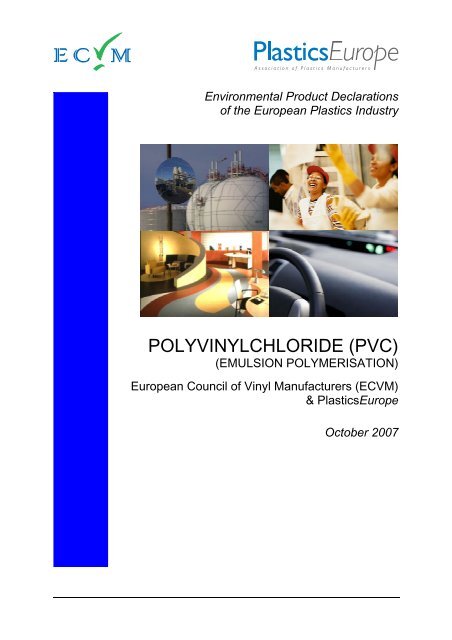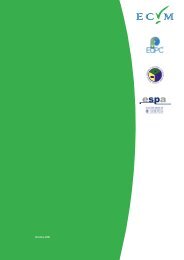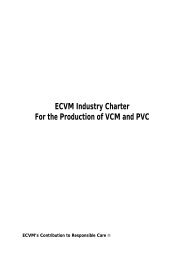EPD E-PVC Final Draft 2007-10-26 - PVC Info
EPD E-PVC Final Draft 2007-10-26 - PVC Info
EPD E-PVC Final Draft 2007-10-26 - PVC Info
Create successful ePaper yourself
Turn your PDF publications into a flip-book with our unique Google optimized e-Paper software.
Environmental Product Declarations<br />
of the European Plastics Industry<br />
POLYVINYLCHLORIDE (<strong>PVC</strong>)<br />
(EMULSION POLYMERISATION)<br />
European Council of Vinyl Manufacturers (ECVM)<br />
& PlasticsEurope<br />
October <strong>2007</strong>
Introduction<br />
This Environmental Product Declaration (<strong>EPD</strong>) is based upon life cycle inventory (LCI) data from PlasticsEurope’s<br />
Eco-profile programme. It has been prepared according to PlasticsEurope’s Product Category Rules<br />
(PCR) for Uncompounded Polymer Resins and Reactive Polymer Precursors (June 2006). <strong>EPD</strong>s provide<br />
environmental performance data, but no information on the economic and social aspects which would be necessary<br />
for a complete sustainability assessment. Further, they do not imply a value judgment between environmental<br />
criteria.<br />
This <strong>EPD</strong> describes the production of the <strong>PVC</strong> polymer. Please keep in mind that comparisons cannot be made<br />
on the level of polymers: it is necessary to consider the full life cycle of an application in order to compare the<br />
performance of different materials and the effects of relevant life cycle parameters. This <strong>EPD</strong> is intended to be<br />
used by member companies, to support product-orientated environmental management; by users of plastics, as a<br />
building block of life cycle assessment (LCA) studies of individual products; and by other interested parties, as a<br />
source of life cycle information.<br />
Description of the Product and the Production Process<br />
This <strong>EPD</strong> is for emulsion polyvinyl chloride (E-<strong>PVC</strong>). E-<strong>PVC</strong> accounts for <strong>10</strong>–15% of the EU <strong>PVC</strong> market. The<br />
functional unit, to which all data given in this <strong>EPD</strong> refer, is 1 kg of E-<strong>PVC</strong> polymer (without additives).<br />
Emulsion Polymerisation<br />
E-<strong>PVC</strong> is produced through either batch emulsion, continuous<br />
emulsion, or micro-suspension polymerisation. All three routes<br />
produce an aqueous latex, i.e. a very fine suspension of <strong>PVC</strong><br />
polymer with mean particle sizes between 0.1 and 3 µm and<br />
thus much smaller than those produced by suspension polymerisation.<br />
Liquid vinyl chloride is insoluble in water and disperses<br />
to fine droplets when mechanically agitated in presence of an<br />
emulsifier. The reaction takes place in pressurised vessels under<br />
the influence of heat, initiators and/or catalysts. In the batch<br />
process, the polymerisation takes place at the VCM–water interface<br />
with a water-soluble initiator. In the continuous process,<br />
VCM, emulsifiers and initiator are fed into the reactor and <strong>PVC</strong><br />
latex is withdrawn continuously. Alternatively, microsuspension<br />
produces latex with a wider particle size distribution:<br />
here, polymerisation takes place within the dispersed VCM<br />
droplets, with an initiator highly soluble in VCM, but not in water.<br />
In each case, the reaction is exothermic and heat is removed<br />
in order to keep temperatures constant. Latex is transferred to a<br />
blow-down vessel; unreacted monomer is extracted, recovered<br />
and recycled back to the polymerisation reactor. The polymer particles are then dried.<br />
Data Sources and Allocation<br />
All data refer to a European industry average (reference year 2005); all calculations were updated in 2006.<br />
ECVM’s and PlasticsEurope’s member companies supplied information on the production of hydrocarbon precursors,<br />
on chlorine and the relevant intermediates EDC and VCM. <strong>Info</strong>rmation on the production of fuels, energy<br />
and the main hydrocarbon resources was derived from the reports of the International Energy Agency. Data<br />
for ancillary operations and transport were obtained from other manufacturers and operators as well as publicly<br />
available LCI databases. Mass allocation was used for multi-output processes. Vertical averaging was performed<br />
to take into account company- and site-specific production routes and to protect confidentiality.<br />
Use Phase and End-of-life Management<br />
By choosing suitable stabilisers and plasticisers, <strong>PVC</strong> can be converted into a wide variety of different products.<br />
E-<strong>PVC</strong> can be extruded in rigid profiles when high surface gloss and smoothness are required. But mainly,<br />
E-<strong>PVC</strong> is dispersed in plasticiser to produce a mix known as plastisol. Plastisol is spread or sprayed, then heatcured.<br />
Typical applications are cushion flooring, wall coverings, coated fabrics, gloves, rotational and slush<br />
mouldings, such as interior car parts, steel coatings and automotive under-body sealants.<br />
For responsible end-of-life management, ECVM recommends recycling, as far as economically feasible and<br />
ecologically sensible. Alternatively, feedstock recycling or energy recovery can be conducted in specialized<br />
plants equipped for recycling hydrochloric acid. In LCA studies, credits for recovered products may be awarded<br />
on the basis of substituted virgin materials, if functionally equivalent.
Environmental Performance<br />
The production of 1 kg of emulsion <strong>PVC</strong> polymer (E-<strong>PVC</strong>, without additives) is associated with environmental<br />
impacts as represented by the following performance indicators.<br />
Input Parameters<br />
Indicator Unit Value<br />
Non-renewable materials<br />
• Minerals g 796.000<br />
• Fossil fuels g 1,490.000<br />
• Uranium g 0.014<br />
Renewable materials<br />
g 0.6<strong>26</strong><br />
(biomass)<br />
Water use 1) g 11,000.000<br />
Non-renewable energy<br />
resources 2)<br />
• for energy MJ 38.20<br />
• for feedstock MJ 27.70<br />
Renewable energy resources<br />
(biomass) 2)<br />
• for energy MJ 1.52<br />
• for feedstock MJ 0<br />
1)<br />
Only process water, cooling water not included.<br />
2)<br />
Calculated as upper heating value (UHV).<br />
Output Parameters<br />
Indicator Unit Value<br />
GWP kg CO 2 2.500<br />
ODP g CFC-11 n/a 3)<br />
AP g SO 2 7.000<br />
POCP (CML 2002) 4) g Ethene 0.450<br />
NP (CML 2002) g PO 4 0.800<br />
Dust/particulate matter g PM<strong>10</strong> 0.750<br />
Total particulate matter g 0.827<br />
Waste<br />
• Non-hazardous kg 0.225<br />
• Hazardous kg 0.005<br />
3)<br />
Relevant LCI entries are below quantification limit.<br />
4)<br />
See note in glossary.<br />
Additional Environmental and Health<br />
<strong>Info</strong>rmation<br />
The methodology for assessing toxicity impacts on<br />
humans and the environment within LCA is still<br />
subject to scientific debate and cannot support business<br />
decisions yet. Additionally, emissions potentially<br />
contributing to toxicity impacts originate essentially<br />
from the combustion of fuels for energy<br />
production and from oil refinery, not from specific<br />
<strong>PVC</strong> processes.<br />
ECVM has issued Industry Charters for the production<br />
of VCM in 1994 and for E-<strong>PVC</strong> in 1998. These<br />
Charters set tight limits on VCM emissions and on<br />
the maximum amount of residual VCM present in<br />
<strong>PVC</strong> resin. The inter-governmental Oslo and Paris<br />
Commissions for the Protection of the North Sea<br />
(OSPAR) later issued two decisions on emissions<br />
from VCM and S-<strong>PVC</strong> plants and a recommendation<br />
for emissions from E-<strong>PVC</strong> plants: limits imposed by<br />
OSPAR for VCM emissions are broadly in line with<br />
the limits specified in the Charter. The companies<br />
that signed the charters undergo an independent<br />
third-party verification of compliance. The levels of<br />
monomer and other volatile organic compounds in<br />
<strong>PVC</strong> resin are very low and do not present any<br />
health or environmental risk.<br />
The 'Voluntary Commitment of the <strong>PVC</strong> Industry'<br />
(including additive producers and converters),<br />
signed in March 2000 and revised in 2005, is an integrated<br />
approach to deliver responsible cradle-tograve<br />
management. This Commitment is now known<br />
under the name Vinyl 20<strong>10</strong>: it addresses key issues<br />
across the <strong>PVC</strong> lifecycle. Vinyl 20<strong>10</strong> contains quantifiable<br />
targets. Progress reports show that European<br />
<strong>PVC</strong> industry has been forging ahead with continuous<br />
environmental improvement and resource efficiency<br />
through a 'learning by doing' approach,<br />
strengthening the partnership within their supply<br />
chain. More information is available on:<br />
www.vinyl20<strong>10</strong>.org.<br />
Additional Technical <strong>Info</strong>rmation<br />
<strong>PVC</strong> is easy to recycle mechanically several times in<br />
conventional equipment. Large quantities of preconsumer<br />
<strong>PVC</strong> are already being recycled, and the<br />
recycling of post-consumer <strong>PVC</strong> is increasing steadily.<br />
Other options are mechanical recycling by dissolution<br />
processes (extracting <strong>PVC</strong> from products), or<br />
feedstock recycling (recovery of a basic chemical<br />
substance). The main difficulty for the recycling of<br />
post-consumer <strong>PVC</strong> is in collecting suitable waste at<br />
an acceptable cost. This is the case for all plastics as<br />
well as many other materials.<br />
<strong>PVC</strong>, like other thermoplastics, has intrinsic energy,<br />
which can be utilized through energy recovery operations.<br />
The chlorine part ends up in the form of<br />
hydrochloric acid, which can also be recovered, purified<br />
and re-used. Flexible <strong>PVC</strong> will generally contribute<br />
a higher energy content than rigid <strong>PVC</strong>, although<br />
even rigid <strong>PVC</strong> has a calorific value similar<br />
to paper. Recovering both hydrochloric acid and energy<br />
significantly increases the eco-efficiency of incineration<br />
or other recovery options.<br />
Landfilling is the least sustainable waste treatment<br />
option for all plastics. A study carried out in 2002–<br />
2003 in order to compare different end-of-life treatment<br />
options for <strong>PVC</strong>-rich waste concluded that all<br />
recovery/recycling options are preferable to landfill.<br />
Additional Economic <strong>Info</strong>rmation<br />
ECVM’s member companies undertake further efforts<br />
to reduce climate impacts, e.g. by introducing<br />
energy-saving technologies such as membrane electrolysis.<br />
<strong>PVC</strong> is among the polymers with the lowest<br />
releases of greenhouse gases per kg. The remaining<br />
greenhouse gas emissions related to <strong>PVC</strong> production<br />
can be addressed, e.g. through offsetting, as offered<br />
by a number of non-profit organisations. For typical<br />
<strong>PVC</strong> applications the cost of offsetting these remaining<br />
emissions amounts to less than 1 % of the product<br />
price. This demonstrates how economic and environmental<br />
aspects can be combined to achieve the<br />
fastest possible progress towards a sustainability objective.
<strong>Info</strong>rmation<br />
Company/Association<br />
European Council of Vinyl Manufacturers<br />
(ECVM)<br />
Contact person: Arjen Sevenster<br />
Avenue E van Nieuwenhuyse 4, Box 3, B–1160<br />
Brussels, Belgium<br />
Telephone: +32 (2) 6753297, Fax: +32 (2) 6753935,<br />
E-mail: info@plasticseurope.org.<br />
Programme Manager<br />
Five Winds International<br />
Contact person: Dr. Ivo Mersiowsky<br />
Gölzstraße 12, D–72072 Tübingen, Germany<br />
Telephone: +49 (7071) 68873–0,<br />
E-mail: info@fivewinds.com.<br />
This Environmental Product Declaration has been<br />
reviewed by Five Winds International. It is approved<br />
according to the Product Category Rules PCR 2006-<br />
06 for Uncompounded Polymer Resins and Reactive<br />
Polymer Precursors and ISO FDIS 14025.<br />
Registration number: PlasticsEurope-<strong>2007</strong>-0002;<br />
validation expires on 31 December 2009.<br />
Glossary<br />
Acidification potential, AP — An environmental impact category<br />
(“acid rain”). Emissions (e.g. sulphur oxides, nitrous oxides,<br />
ammonia) from transport, energy generation, combustion processes,<br />
and agriculture cause acidity of rainwater and thus damage<br />
to woodlands, lakes and buildings. Reference substance: sulphur<br />
dioxide.<br />
Environmental Product Declaration, <strong>EPD</strong> — A standardised<br />
method (ISO 14025) of communicating the environmental performance<br />
of a product or service based on LCA data.<br />
Ethylene dichloride, EDC — A precursor of the vinyl chloride<br />
monomer (VCM).<br />
Global warming potential, GWP — An environmental impact<br />
category (“greenhouse effect”). Energy from the sun drives the<br />
earth’s weather and climate, and heats the earth’s surface. In turn,<br />
the earth radiates energy back into space. Atmospheric greenhouse<br />
gases (water vapour, carbon dioxide, and other gases) are<br />
influencing the energy balance in a way that leads to an increased<br />
average temperature on earth’s surface. Problems arise when the<br />
atmospheric concentration of greenhouse gases increases due to<br />
the “man-made” (or anthropogenic) greenhouse effect: this additional<br />
greenhouse effect caused by human activities may further<br />
increase the average global temperature. The index GWP is calculated<br />
as a multiple equivalent of the absorption due to the substance<br />
in question in relation to the emission of 1 kg of carbon<br />
dioxide, the reference substance, over <strong>10</strong>0 years.<br />
Life Cycle Assessment, LCA — A standardised management<br />
tool (ISO 14040–44) for appraising and quantifying the total environment<br />
impact of products or activities over their entire life cycle<br />
of particular materials, processes, products, technologies, services<br />
or activities.<br />
Nutrification potential, NP — An environmental impact category<br />
(“over-fertilisation”). Emissions such as phosphate, nitrate,<br />
nitrous oxides, and ammonia from transport, energy generation,<br />
agriculture (fertilisers) and wastewater increase the growth of<br />
aquatic plants and can produce algae blooms that consume the<br />
Programme Owner<br />
PlasticsEurope<br />
Contact person: Riccardo Fabiani<br />
Avenue E van Nieuwenhuyse 4, Box 3, B–1160<br />
Brussels, Belgium<br />
Telephone: +32 (2) 6753297, Fax: +32 (2) 6753935,<br />
E-mail: info@plasticseurope.org.<br />
For copies of this <strong>EPD</strong>, for the underlying LCI data<br />
(eco-profile), and for additional information, please<br />
refer to http://www.plasticseurope.org/.<br />
References<br />
• Product photographs on cover with kind permission<br />
of Hydro Polymers.<br />
• PlasticsEurope: Polyvinylchloride <strong>PVC</strong> (Emulsion<br />
Polymerisation). Eco-profiles of the European<br />
Plastics Industry. Brussels, April 2006.<br />
• PlasticsEurope: Product Category Rules (PCR)<br />
for Uncompounded Polymer Resins and Reactive<br />
Polymer Precursors. Brussels, June 2006.<br />
• ISO FDIS 14025 : Environmental Labels and<br />
Declarations – Type III Environmental Declarations.<br />
Geneva, 2005.<br />
oxygen in water and thus smother other aquatic life. This is called<br />
eutrophication and causes damages to rivers, lakes, plants, and<br />
fish. Reference substance: phosphate.<br />
Offsetting — Financing activities which compensate the climate<br />
effect (and often at the same time also the use of non-renewable<br />
resources) resulting from the production.<br />
Ozone depletion potential, ODP — An environmental impact<br />
category (“ozone hole”). The index ODP is calculated as the contribution<br />
to the breakdown of the ozone layer that would result<br />
from the emission of 1 kg of the substance in question in relation<br />
to the emission of 1 kg of CFC-11 (a freon) as a reference substance.<br />
Photochemical ozone creation potential, POCP — An environmental<br />
impact category (“summer smog”). The index used to<br />
translate the level of emissions of various gases into a common<br />
measure to compare their contributions to the change of groundlevel<br />
ozone concentration. The index POCP is calculated as the<br />
contribution to ozone formation close to the ground due the substance<br />
in question in relation to the emission of 1 kg of ethene as<br />
a reference substance. NOTE: Due to recent methodology developments,<br />
nitrous oxides and carbon monoxide are now taken into<br />
account for POCP calculation; accordingly, figures cannot be<br />
compared anymore with previous POCP results.<br />
Polyvinyl chloride, <strong>PVC</strong> — A halogenated polymer based on the<br />
raw materials petrochemicals (oil and gas) and salt (sodium chloride).<br />
Vinyl chloride monomer, VCM — A precursor of polyvinyl<br />
chloride (<strong>PVC</strong>).<br />
Product Category Rules, PCR — A set of rules for the preparation<br />
of LCA and <strong>EPD</strong> within a functionally defined class of products.<br />
A PCR document is a necessary component of any Type III<br />
Environmental Declaration programme (ISO 14025).





